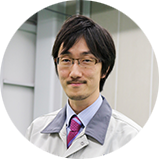Development of a remote radiation imaging system

Interviewee
Dr Yuki Sato
Research purpose and contents
One of the most important issues at reactor decommissioning sites inside the Fukushima Daiichi Nuclear Power Station (hereinafter referred to as FDNPS) building is reducing workers’ exposure dose. Therefore, it is vital to accurately understand the distribution of radioactive substances, including that in hot spots (localized areas with high-dose rates compared to the surrounding areas), and secure the safety . The objective of developing a remote radiation imaging system is to make it possible to safely and smoothly execute reactor decommissioning activities by measuring and visualizing hot spots through remote operation.
 Compact lightweight Compton camera
Compact lightweight Compton camera( a device based around a Compton Camera jointly developed by Hamamatsu Phototonics and Waseda University)
Measurement using a compact camera
We have developed a compact, lightweight Compton camera to visualize radioactive substances. This enables us to quickly identify hot spots over a wide-area. Currently, we are conducting verification tests in FDNPS, and have succeeded in detecting several hot spots (*1).Furthermore, by making it compact and lightweight, it can be mounted on a crawler robot to measure the workplace, and it can be attached to a drone to perform outdoor measurements over a wide area. In addition, it is possible to perform measurements while changing the type or settings of the Compton camera to match the dose rate of each area.
Three-dimensional visualization of radioactive substances
“Making something three-dimensional” is the technology to express a measured result in an easy-to-understand way. By overlapping the hot spot image acquired using a Compton Camera with a three-dimensional model of the workplace, it is possible to present a three-dimensional position and spread of hot spots. The three-dimensional model is constructed with a technique known as photogrammetry, which is already used in civil engineering surveys and the movie industry. This is a photographic measurement technique in which three-dimensional data are created from photographic data captured using a digital camera. In addition to photogrammetry, we developed a technique to visualize hot spots in combination with a more precise three-dimensional model that uses a three-dimensional laser scanner. With a system that combines the laser scanner (3D-LiDAR) with a Compton camera, we succeeded in realizing three-dimensional radiation imaging by overlapping three-dimensional model data of the surrounding areas obtained using the laser scanner with hot spot images obtained with the Compton camera. This has an advantage that it can perform measurements even in dark locations and that three-dimensional models can be created with higher precision than photogrammetry. However, its disadvantage is that the target color information of the subject cannot be obtained, and the device is expensive. It is necessary to complement these advantages and disadvantages and use different devices depending on the requirements of a situation.
 Three-dimensional laser scanner used in tests
Three-dimensional laser scanner used in tests(Stencil2 by Kaarta, Inc., USA)
 The resultant image of the hot spots obtained from the Compton camera is overlaid on the
three-dimensional model inside the FDNPS building constructed using the photogrammetry technique
(*2).
The resultant image of the hot spots obtained from the Compton camera is overlaid on the
three-dimensional model inside the FDNPS building constructed using the photogrammetry technique
(*2).
 The resultant image of the hot spots acquired from the sky using a drone and the Compton
camera is overlaid on the three-dimensional model of the outdoor environment constructed using a
three-dimensional laser scanner. An aerial photograph is pasted on a three-dimensional model.
This measurement was performed using a drone system that has been jointly developed with Chiyoda
Technol (*3).
The resultant image of the hot spots acquired from the sky using a drone and the Compton
camera is overlaid on the three-dimensional model of the outdoor environment constructed using a
three-dimensional laser scanner. An aerial photograph is pasted on a three-dimensional model.
This measurement was performed using a drone system that has been jointly developed with Chiyoda
Technol (*3).
Visualization of the distribution of radioactive substances for the smooth implementation of FDNPS decommissioning work.
We hope that personnel working at the FDNPS would use these devices for identifying a hot spot and deciding on a decontamination plan.Note that the current system still faces the issue that in environments with high radiation dose in the deep part of the reactor buildings of FDNPS, the signal processing capacity of the Compton camera cannot is insufficient. By sequentially resolving such issues, we are aiming to create a device that will be easier to use on site.Furthermore, we aim to provide personnel who engage in reactor decommissioning work with reassurance and safety through our research and development.
Related information
| Researcher | Yuki Sato(researchmap) |
|---|
| References | *1…Y. Sato, Y. Tanifuji, Y. Terasaka et. al., Radiation imaging using a compact Compton
camera inside the Fukushima Daiichi Nuclear Power Station building, Journal of Nuclear
Science and Technology, 55, pp. 965-970, (2018). *2…Y. Sato, Y. Terasaka, W. Utsugi et. al., Radiation imaging using a compact Compton camera mounted on a crawler robot inside reactor buildings of Fukushima Daiichi Nuclear Power Station, Journal of Nuclear Science and Technology, 56, pp. 801-808, (2019). *3… Japan Atomic Energy Agency, Chiyoda Technol Corp., Press release. Rapid three-dimensional visualization of radiation distribution in the environment from the sky —Development of a drone-mounted camera system— May 9, 2019 |
|---|